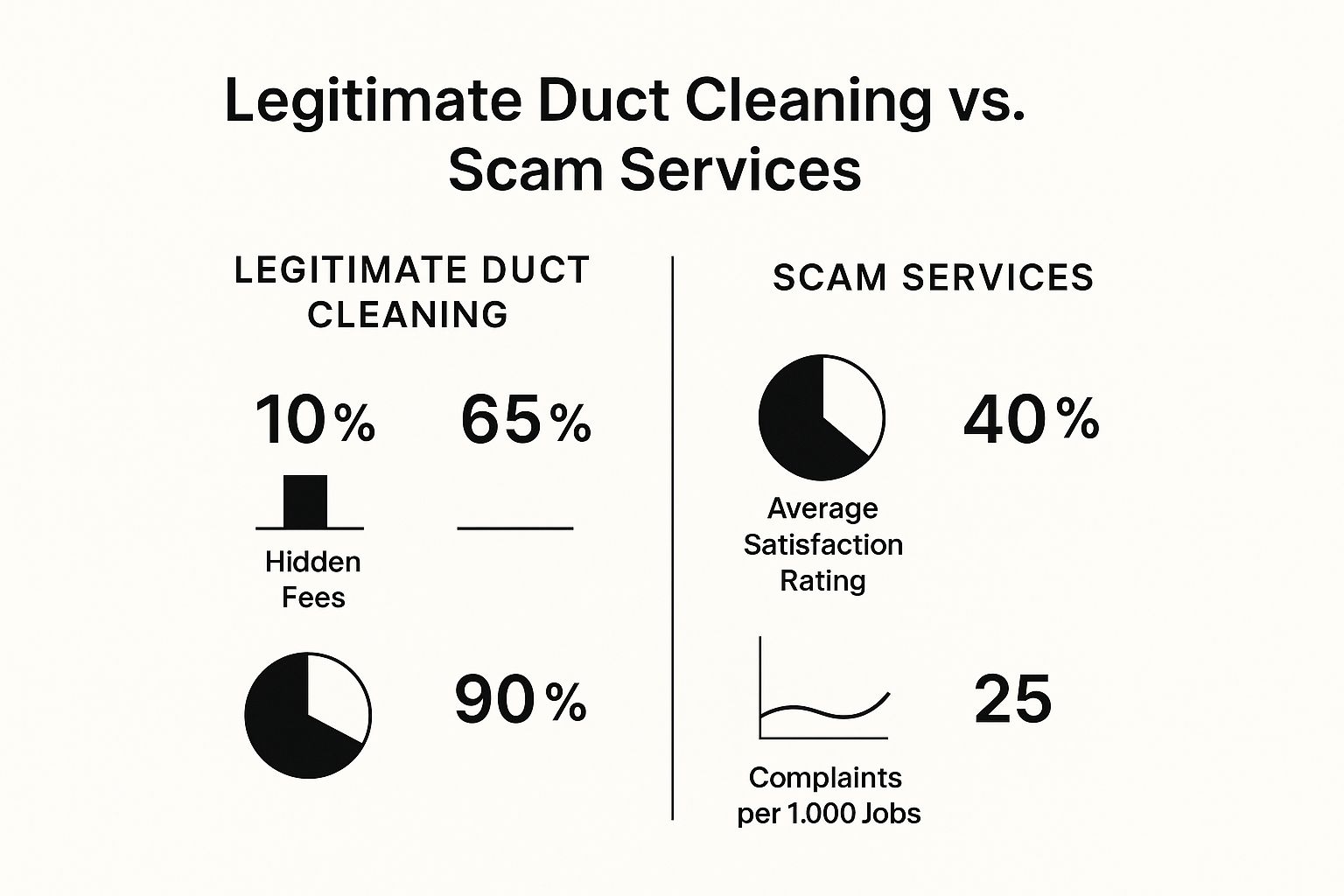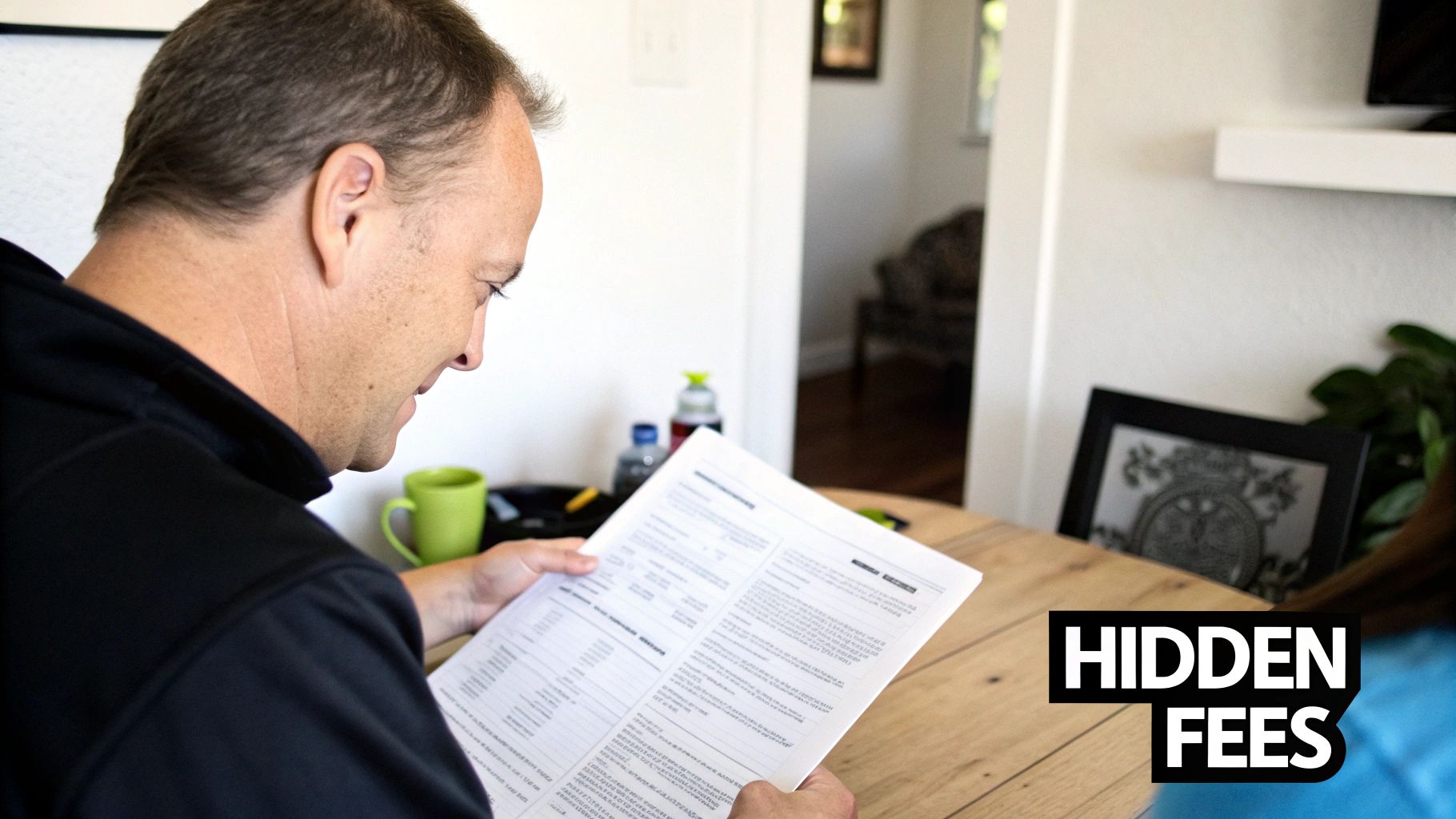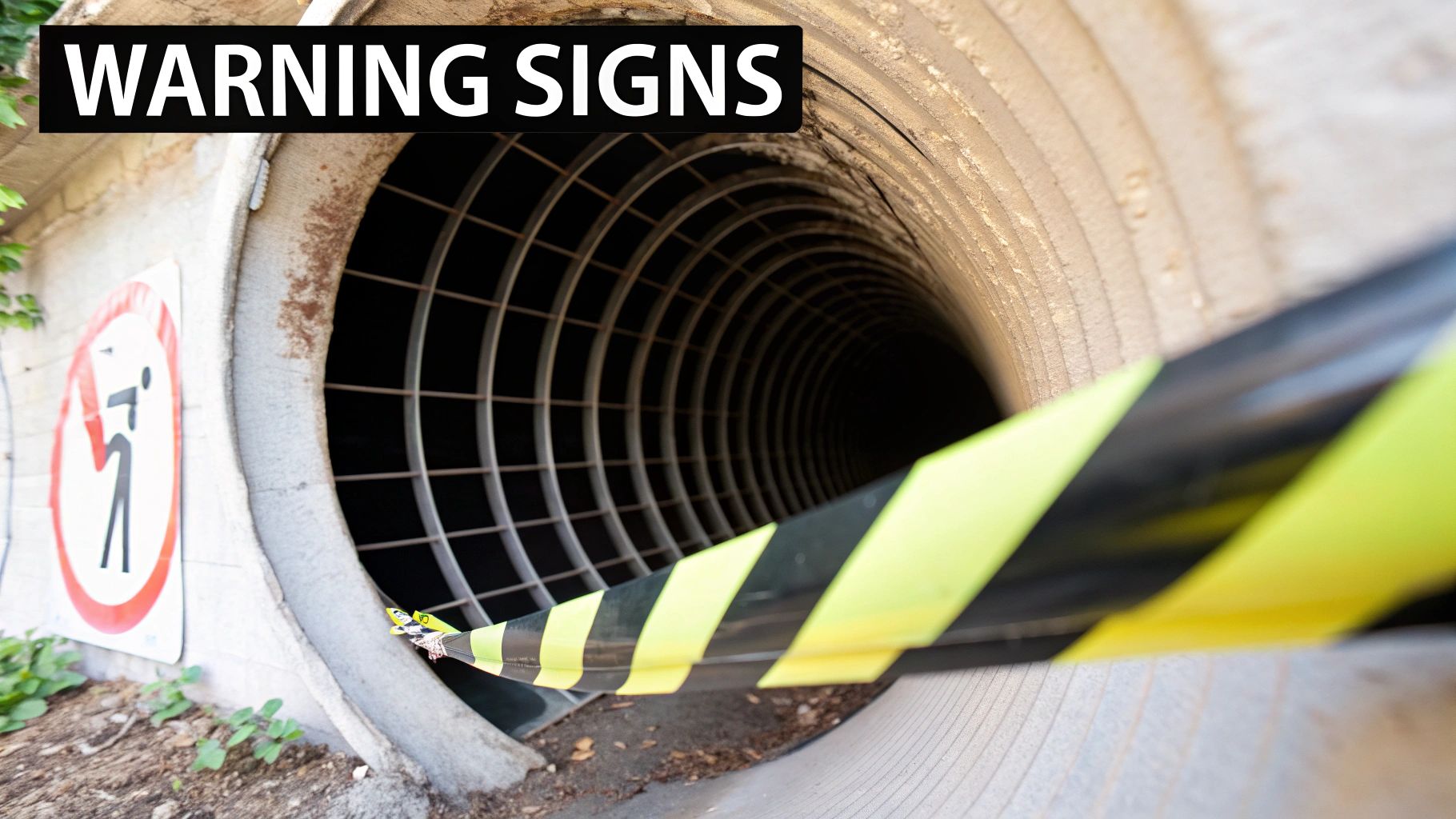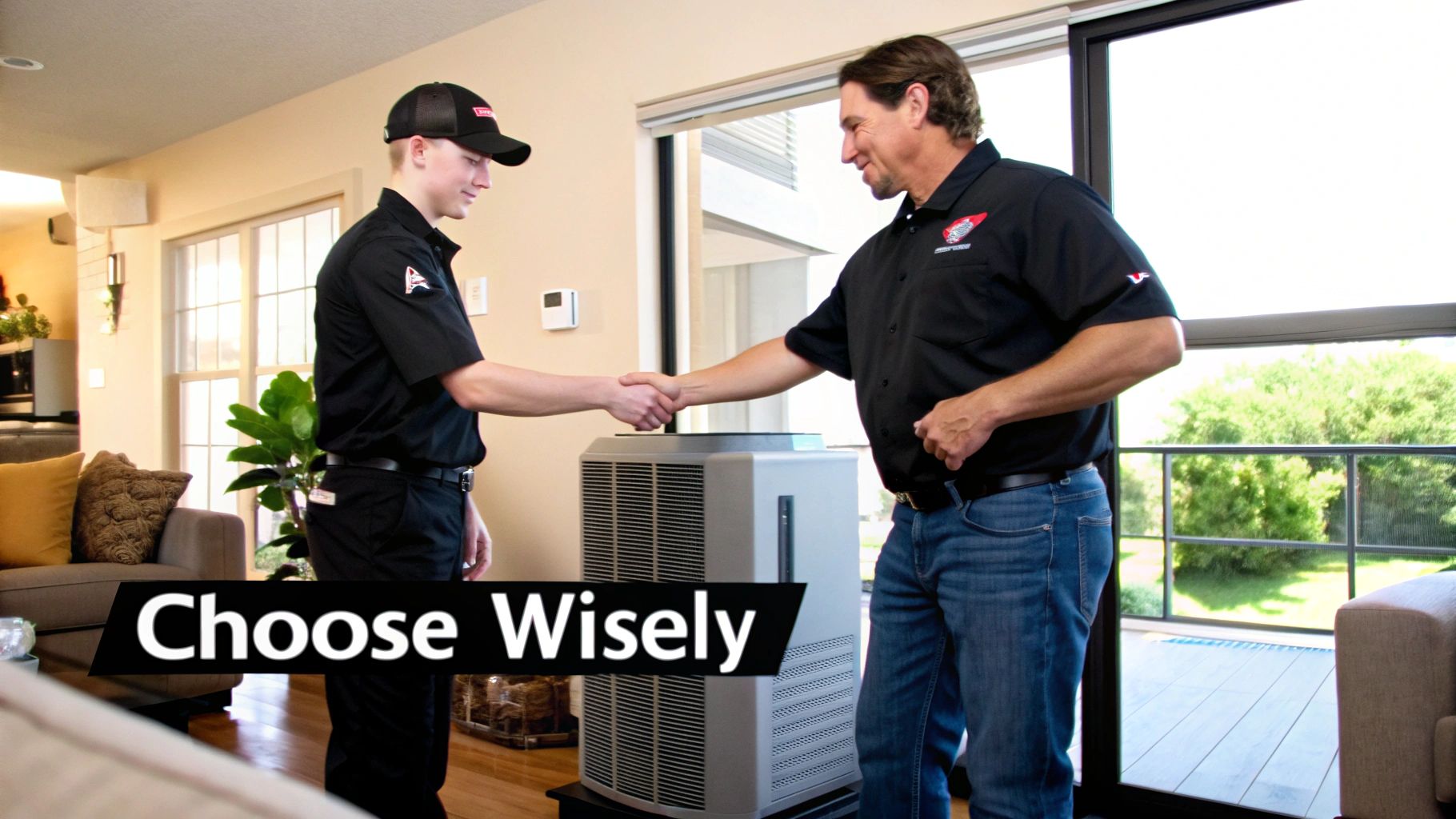That unbelievably low $49 whole-house duct cleaning offer you saw? Let’s be honest, it’s almost certainly a trap. This is the oldest trick in the book, a classic bait-and-switch, and it's the number one way scammers get their foot in your door.
The Bait-And-Switch Unpacked
Think of that rock-bottom price as a key, not the final bill. The scammers have zero intention of honouring it. The real goal is to get a salesperson—disguised as a technician—into your home. Once they're in, the conversation quickly shifts from cleaning to a high-pressure sales pitch, turning a simple job into a massive, unexpected expense.
It's a strategy that works because it plays on our natural desire to find a great deal. You see an ad, think you’re getting a professional service for a steal, and book the appointment without a second thought. That's exactly what they're counting on.
How The Scam Escalates
The switch happens almost immediately after the "technician" arrives. They'll often do a quick, sloppy job on a few vents—a classic "blow-and-go"—before suddenly "discovering" a serious, urgent problem that needs immediate attention. This is where the scare tactics kick in.
Common excuses they'll use to upsell you include:
- Sudden Mould Discovery: The technician might show you a blurry photo on their phone or a fake test swab, claiming your ducts are infested with toxic mould that requires expensive, immediate remediation.
- Pest Infestation Warnings: They'll suddenly find "evidence" of rodents or insects, insisting you need a costly extermination and cleaning package to protect your family from disease.
- Exaggerated Debris Claims: You'll be told your system is so clogged it's a major fire hazard or is killing your HVAC system's efficiency, pressuring you into a much more comprehensive—and expensive—service.
Scam Tactics Versus Legitimate Service Practices
It's hard to know what's real and what's a scare tactic in the moment. This quick comparison table should help you instantly tell the difference between a potential scammer and a true HVAC professional.
| Warning Sign of a Scam | Hallmark of a Legitimate Pro |
|---|---|
| Advertises an extremely low price (e.g., $49 "whole house" special). | Provides a detailed, transparent quote based on your home's size and system. |
| Uses high-pressure sales tactics and creates a sense of extreme urgency. | Educates you on your system's condition and explains options without pressure. |
| "Discovers" a major problem like mould or pests that requires an expensive add-on. | Uses proper diagnostic tools and provides clear, verifiable evidence for any issues found. |
| Performs a quick, superficial cleaning (often in under an hour). | Follows a thorough, multi-step process that takes several hours to complete. |
| Arrives in an unmarked vehicle with basic, often portable, cleaning equipment. | Arrives in a branded company vehicle with powerful, truck-mounted equipment. |
| Cannot provide proof of insurance, licensing, or professional certifications. | Readily provides all credentials and encourages you to check their reviews and reputation. |
The bottom line is that a true professional is there to solve a problem, not invent one.
As the data shows, these scam operations almost always lead to hidden fees, poor results, and a pile of frustrated customer complaints.

The core of the bait-and-switch is to create a fake emergency. The scammer invents a problem that only their overpriced, on-the-spot services can "fix," turning your initial $49 quote into a bill that can easily top $500 or more.
This isn't a rare occurrence; it's a growing problem. Scams are exploding across social media, with ads for $29 to $99 services luring in homeowners before the final bill gets padded with hundreds, or even thousands, in unnecessary extras. By knowing what these deceptive patterns look like, you can protect yourself.
To get a deeper understanding of what to watch for, you might be interested in our complete guide on identifying common air duct cleaning scams.
Recognizing High-Pressure Sales Tactics

Once a scammer gets their foot in your door, the real show begins. That rock-bottom advertised price? It was just the bait. Now, you’re face-to-face with an aggressive, psychologically manipulative sales pitch designed to sell you services you almost certainly don't need.
These tactics are all about creating panic and a false sense of urgency. It’s a well-rehearsed performance.
One of their greatest hits is the sudden "mould discovery." The technician vanishes into your basement for a few minutes and comes back with a grim expression. They might flash a stock photo of mouldy ducts on their tablet or use a phony test kit that—surprise!—turns a frightening colour. Just like that, they’re telling you your family's health is in immediate danger.
Decoding Common Pressure Tactics
This manufactured crisis is engineered to bypass your rational thinking. They want you to make an emotional, fear-based decision on the spot. Another classic move is the vague "whole-house special" that, once they arrive, is revealed to only cover an arbitrary, small number of vents.
Need the rest of your home cleaned? That’ll be an unexpectedly high per-vent fee they conveniently forgot to mention on the phone. These surprise charges are the bread and butter of duct cleaning scams.
Key Insight: A legitimate professional educates you about your system and provides verifiable proof of any issues they find. A scammer, on the other hand, uses fear and misinformation to corner you into an immediate, overpriced "fix."
Unfortunately, this approach is far too common. Surveys show that roughly 25% of homeowners have dealt with these exact high-pressure tactics, where technicians invent urgent health threats to push expensive, on-the-spot add-ons.
How to Hold Your Ground
Spotting these behaviours is the first step toward protecting yourself. A scammer will often brush off your questions, give you rushed explanations, and insist that the problem needs to be solved right now. They create a false emergency to stop you from doing the one thing they don't want you to do: get a second opinion.
Keep an eye out for these warning signs of a high-pressure pitch:
- Creating a False Emergency: They "discover" a terrifying problem like toxic mould or a dangerous blockage that needs immediate and costly repairs.
- Vague or Evasive Answers: When you ask for details about the problem or how they plan to fix it, they give you confusing non-answers or try to change the subject.
- Discouraging Second Opinions: You’ll hear things like, "This special price is only good for today," or, "If you wait, you could cause permanent damage to your HVAC system."
- Refusing to Provide a Written Quote: Everything is verbal, leaving you with no clear record of the proposed work or charges.
If you encounter any of these red flags, it’s a clear signal to show them the door. You can always learn more about how to avoid falling for a duct cleaning scam to feel more prepared.
Remember, you are always in control of who works in your home. A true professional will respect your right to say no, get other quotes, and take the time you need to make a decision.
Why Social Media Is a Hotbed for HVAC Scams
Your neighbourhood Facebook group probably feels like a safe place to ask for recommendations, right? Unfortunately, these local forums have become a favourite hunting ground for duct cleaning scammers. They absolutely love social media because it lets them hide behind a screen with zero accountability.
Think about it: a scammer can whip up a fake business profile in minutes. They’ll often steal photos from a legitimate company's website to look the part, then flood their own posts with glowing, five-star comments from dozens of fake accounts they also control. Suddenly, they look like a beloved local business.
This digital smoke and mirrors act makes it incredibly tough for the average homeowner to spot the difference between a real pro and a fraudster just looking for a quick payday.
Spotting Scam Posts in Your Feed
These scammy posts are designed to look just like any other local ad, but they almost always have a few dead giveaways. Once you know the signs, they’re actually pretty easy to pick out from the crowd.
Here’s what a typical scam post includes:
- Pixelated Stock Images: Instead of real photos of their team or equipment in action, they use blurry, generic stock photos of air ducts.
- Vague Company Details: You won't find a physical address, a link to a professional website, or a registered business number anywhere.
- Comments Turned Off: They shut down the comments to stop past victims from posting warnings and exposing the scam.
- Instant Messaging Only: They’ll insist you communicate through private message. This keeps their shady practices out of the public eye and lets them apply high-pressure sales tactics one-on-one.
The whole strategy preys on the speed of social media. A quick click and a DM can have a "technician" booked for your home before you've even had a moment to think it through or do any real digging.
This isn't just a small-time problem; it's everywhere. Local community forums are drowning in these kinds of deceptive offers. In fact, a 2023 report found that roughly 40% of complaints about duct cleaning services in California were related to unlicensed operators or companies that took the money and never did the work—with most of these scams starting on social media. You can learn more about how to identify these fraudulent duct cleaning offers and keep your home safe.
The ease of creating these fake personas is exactly why social media is such a powerful tool for scammers. They can target specific neighbourhoods with ads, manufacture a false sense of trust with fake reviews, and then vanish without a trace. Always, always treat social media offers with a healthy dose of skepticism and do your own homework before letting anyone into your home.
Your Checklist for Finding a Trustworthy Professional

Alright, so you know how to spot the red flags of a duct cleaning scam. Now for the most important part: how do you find someone who will actually do a good job? Sifting through local companies can feel like a chore, but having a clear game plan makes all the difference. This checklist will help you hire a true professional with confidence.
Think of it this way—you wouldn't hire a plumber without checking their qualifications first. Your HVAC system is the lungs of your home, and it deserves the same level of care and scrutiny.
Start with NADCA Certification
The very first filter you should apply is looking for a National Air Duct Cleaners Association (NADCA) certification. This isn't just a logo they can slap on their van; it's proof that the company plays by the rules. It means they follow a strict code of ethics and their technicians are trained on the right equipment and safety protocols.
A company that isn't NADCA certified is a serious gamble. Reputable professionals invest their own time and money into getting accredited because it shows they’re serious about their work. Don't skip this step.
You can instantly find certified pros in your area using the "Find a Professional" tool on the NADCA website. This one simple search will weed out countless unqualified operators right off the bat.
Verify Their Licensing and Insurance
Next up, a legitimate business must be properly licensed and insured to work in your area. This is non-negotiable and protects you. Always ask to see proof of their liability insurance and workers' compensation.
- Liability Insurance: This covers your home and property in the unlikely event something gets damaged during the service.
- Workers' Compensation: This protects you from being on the hook financially if a technician gets injured on your property.
A professional company will have these documents ready and won't hesitate to show you. If they get defensive or make excuses, that's your cue to hang up the phone. A real business with a physical address and local number understands this is just part of earning your trust.
Scrutinize Reviews and Insist on a Written Quote
Once you have a shortlist, it's time to do some digging into their reputation. Check out online reviews, but be smart about it. Look beyond the glowing testimonials on their own site and head to third-party platforms like Google, Yelp, and the Better Business Bureau (BBB). You're looking for consistent patterns—good or bad—that tell the real story.
If you’re still not sure what issues to look for, you can learn more about how to spot the signs of blocked air ducts from our other resources.
Finally, never, ever agree to a job without a detailed, written estimate. A legitimate quote will break everything down: the total cost, exactly what's included (all ducts, registers, coils, air handler), and any other potential fees. A vague price over the phone is the classic setup for a bait-and-switch. A written contract ensures there are no last-minute surprises.
Homeowner Vetting Checklist for Duct Cleaning
Follow these essential steps to ensure you're hiring a qualified and trustworthy duct cleaning professional.
| Verification Step | What to Look For | Why It's Critical |
|---|---|---|
| NADCA Certification | An active certification on the official NADCA "Find a Professional" directory. | Confirms adherence to industry standards, ethics, and proper training. |
| Business Legitimacy | A physical business address, local phone number, and professional website. | Scammers often use P.O. boxes or mobile numbers to remain anonymous and avoid accountability. |
| Proof of Insurance | A current Certificate of Insurance showing both general liability and workers' compensation. | Protects you from financial liability for property damage or on-the-job injuries. |
| Independent Reviews | Consistent, detailed feedback on third-party sites like Google, BBB, or Yelp. | Provides an unbiased view of their past performance and customer service. |
| Detailed Written Quote | A formal document outlining the full scope of work, all costs, and terms. No verbal "deals." | Prevents bait-and-switch tactics and ensures there are no surprise fees later. |
| Proper Equipment | Questions about their use of high-powered vacuums, agitation tools, and containment systems. | Verifies they have the professional-grade equipment needed to do the job right, not just a shop vac. |
Taking the time to run through this checklist might feel like a bit of extra work, but it’s the single best way to protect your home, your wallet, and your peace of mind.
What a Real Duct Cleaning Service Looks Like
Knowing what to expect from a legitimate, high-quality duct cleaning service is your best weapon against getting ripped off. A professional job is a world away from simply shoving a vacuum hose into your vents. It’s a methodical process that demands specialized gear and trained technicians who actually care about your home.
The most obvious giveaway between a pro and a scammer is the equipment they use. A reputable company will pull up in a branded truck with a powerful, truck-mounted vacuum system. We’re not talking about a shop vac from a big box store; this is an industrial-strength machine designed to create immense negative pressure throughout your ductwork. This ensures all the dislodged gunk is pulled out of your home, not just stirred up into the air.
The Professional Process Step by Step
A proper service call starts long before the vacuum ever gets turned on. The technicians should begin with a walkthrough, inspecting your HVAC system and clearly explaining what they’re about to do. They'll also take steps to protect your space, using drop cloths and corner guards to prevent any scuffs or messes.
Once they're set up, they'll connect their massive vacuum hose to your main ductwork, usually down by the furnace. This is what creates that all-important negative pressure, turning your entire duct system into a self-contained vacuum so no dust escapes.
The actual cleaning is about more than just suction. The technicians use a whole toolkit of specialized gear to physically break loose all the built-up contaminants clinging to the inside of your ducts.
- Agitation Tools: This includes things like high-powered rotating brushes, air whips, and special compressed air nozzles that scrub the interior surfaces clean.
- Systematic Approach: They work methodically through your entire home, cleaning from the vent furthest away from the furnace and working their way back. This guarantees all debris is pulled directly toward the vacuum.
- Comprehensive Cleaning: A real service doesn't stop at the ducts. It includes cleaning the registers and grilles, plus the fan motor, housing, and coils inside your HVAC unit itself.
A "blow-and-go" crew that's in and out in under an hour is a massive red flag. A thorough, professional cleaning for an average-sized home typically takes three to five hours and requires at least two technicians.
What Scammers Do Instead
Compare that to the scammer, who often arrives with nothing more than a portable shop vac. They’ll make a big show of vacuuming the openings of a few vents, creating a lot of noise but accomplishing almost nothing. This surface-level "cleaning" does absolutely nothing for the years of buildup hiding deep inside your system.
Once you understand the real process, you have a clear benchmark for what to look for. If the people in your home aren't following these steps, you're probably dealing with a scam. Considering the harmful effects of dirty air ducts, it's critical to make sure the job is done right from the start. Don't be afraid to ask about their equipment and cleaning methods before you even book an appointment.
What to Do If You Suspect You’ve Been Scammed

It’s a sinking feeling—you realize the "deal" you got on duct cleaning might be a total scam. If the technician in your home is suddenly pressuring you into expensive, unplanned services or the whole job feels off, it's time to act calmly but firmly.
Your first move? Pause everything. You are under no obligation to pay for work you never agreed to. If the final bill has ballooned with surprise charges for things like "emergency mould removal," you have every right to refuse payment on those new items. Make it clear you'll only cover the price you were quoted in writing.
Your Immediate Action Plan
In a situation like this, your smartphone is your best friend. Documentation is everything. Before the crew packs up, start taking clear photos and videos of your vents, their equipment, and any of the "problems" they supposedly uncovered. This evidence is crucial.
Here’s exactly what to do to protect yourself:
- Refuse Unauthorized Charges: Politely but firmly state that you will not pay for any service that wasn't on the original agreement. Ask for an itemized bill that reflects the quote you were given.
- Document Everything: Snap pictures of the work they did (or didn't do), their truck, and its licence plate. Get photos of any paperwork they try to give you.
- Don’t Pay in Cash: If you can, always pay with a credit card. It gives you the power to dispute the charge with your bank if you can prove the service was fraudulent.
Remember, you are in control. A legitimate company will work with you to address your concerns. A scammer will get defensive or aggressive when you push back. Standing your ground is the right call.
Reporting the Scam
Once they're gone, the next step is to report them. This not only helps you but also protects other homeowners from falling into the same trap. File a detailed complaint with consumer protection agencies and the Better Business Bureau (BBB), attaching all the photos and documents you collected.
Knowing the real signs that you need to get your air ducts cleaned will also help you explain exactly why their service was unnecessary or poorly done. By taking these actions, you’re fighting back and holding unethical operators accountable.
Answering Your Top Duct Cleaning Questions
It's easy to get confused about duct cleaning, especially when you hear so many different things. Let's clear the air and tackle some of the most common questions homeowners have.
How Often Should I Really Have My Air Ducts Cleaned?
Honestly, there's no magic number or fixed schedule. The Environmental Protection Agency (EPA) actually advises against cleaning ducts as a routine, scheduled task. Instead, they recommend cleaning them only when you have a specific reason.
So, what’s a good reason? Things like visible mould, a pesky pest problem you’ve confirmed, or if your ducts are genuinely choked with dust and debris, maybe after a big home renovation. A true professional won't try to sell you on a yearly plan; they’ll suggest an inspection if you have a real concern.
Can a Botched Duct Cleaning Job Actually Wreck My HVAC System?
Absolutely. The risk of damage is very real and can be significant. Someone who doesn't know what they're doing might use the wrong equipment or be far too aggressive, easily puncturing flexible ductwork or tearing the insulation.
This isn't just a small boo-boo. Punctured ducts create air leaks, which means your system has to work harder, your energy bills climb, and you could be looking at expensive repairs down the road. It’s a perfect example of why hiring a certified and properly insured pro is non-negotiable.
Is NADCA Certification a Foolproof Way to Avoid a Scam?
Hiring a company certified by the National Air Duct Cleaners Association (NADCA) is the single best step you can take to protect yourself. It dramatically cuts down your risk, as NADCA members have to meet high standards for their work, ethics, and equipment. Think of it as your most important starting point.
But it’s not the only step. Always back it up by checking recent, independent online reviews and getting a detailed, written quote before a single tool comes out. This multi-layered approach is your best defence against getting scammed.
For a trustworthy, professional assessment and cleaning of your HVAC system in the Greater Toronto Area, trust the experts at Can Do Duct Cleaning. Schedule your inspection today and breathe easier knowing your home is in good hands.


